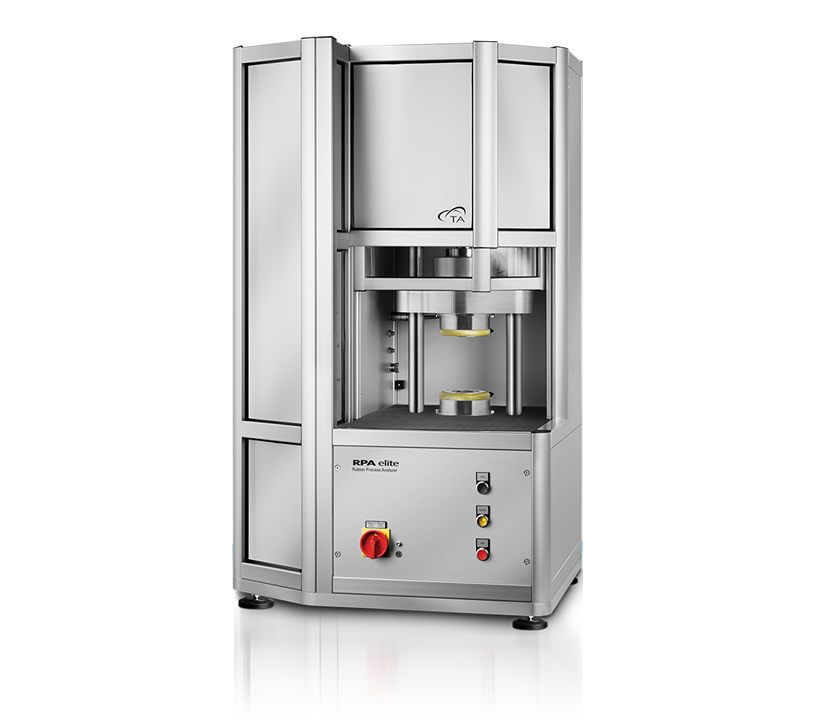
Moving Die Rheometer
Reliable, accurate, and easy-to-operate rotorless curemeter perfect for routine and standards-driven testing of rubber curing.
View brochure Sample Cutter Request a Quote
Sales PromotionsThe MDR one Moving Die Rheometer (MDR) is a reliable, accurate, and easy-to-operate rotorless curemeter perfect for routine and standards-driven testing of rubber curing. The MDR one is configured for measuring curing profiles of rubber compounds under isothermal and non-isothermal test conditions at constant strain and frequency.The MDR one employs sealed biconical dies meeting all relevant ASTM, ISO, and DIN standards.The unique design includes an ultra-rigid test frame, direct drive motor, precision temperature control with optional cooling and intuitive Scarabaeus Control and Analysis software making it the ideal platform for QC or R&D environments.
Features
- Unmatched data precision, accuracy, and reproducibility
- Robust, field proven torque transducer for high stability and reliable torque measurements
- Extremely rigid test frame for accurate compliance free data
- Pneumatic locking cylinders for repeatable sample sealing
- Powerful and intuitive Scarabaeus Software available in multiple languages & compatible with other manufacturers’ instruments
- User calibration and user replaceable seals
| Frequency | 0.1 to 2.0 Hz (6 to 120 cpm) |
| Amplitude | ±0.1°, 0.2°, 0.5°, 1.0°, 3.0°, 5.0° arc |
| Strain | ±1.4%, 2.8 %, 7 %, 14 %, 42 %, 70 % |
| Torque Range | 0.001 to 20 Nm |
| Temperature | Ambient to 230 °C |
| Maximum Ramp Rate | 80°C/min (1.33°C/s) |
| Die Type | Sealed bicone, 0.48 mm gap |
| Sample Volume | 4.5 cm3 |
| Platen Sealing Pressure | Fixed: 4.5 bar |
| Sample Pressure | Optional: 0 to 8,300 kPa |
| Test Modes | Curemeter/Vulcanization both isothermal and temperature ramp |
| Measured Data | Torque, Temperature, Frequency, Amplitude, Sample Pressure (optional) |
| Calculated Data | More than 450 process parameters including: ts1, TC10, TC50, TC90, S’min, S’max, scorch time, cure rate, and viscoelastic properties including: G’, G”, G*, S’, S”, S*, tan δ, η’, η”, η* |
| Standards | ASTM D5289, ISO 6502, 13145; DIN 53529 |
TA Instruments is the world’s leading supplier of analytical instrumentation for the measurement of viscosity and viscoelastic properties. The new rubber testing instruments are uniquely designed to deliver the highest quality of torque, amplitude, frequency, temperature, and pressure measurement and control setting the NEW STANDARD for testing of rubber products at all stages of manufacturing.
Rigid Testing Platform
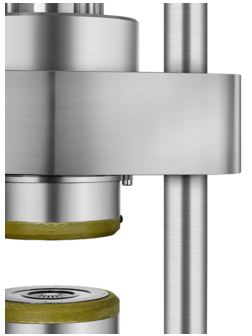 Rigid Testing Platform
Rigid Testing Platform
The MDR One is built with an ultra-stiff testing frame and crosshead which eliminate the effects of instrument compliance on test data. Instrument compliance, or instrument deformation, produces erroneously low values of measured properties such as modulus and torque, irregular strain and torque waveform signals, and other errors.
Large diameter steel rods and a thick crosshead brace in the H-shaped load frame of the MDR One provide unmatched rigidity to resist instrument deflection while the motor deforms the sample. This special design ensures that the commanded strain is achieved with each cycle of deformation, even for highly filled, fully cured rubbers. Additionally, a non-compliant system allows for truly sinusoidal strain profiles under all conditions. This can be verified by continuous Fourier Transform analysis of the deformation and measured torque signals which is available in the Scarabaeus Software. The superior design also guarantees smooth travel, proper alignment, and precise application of vertical load.
Direct Drive Motor
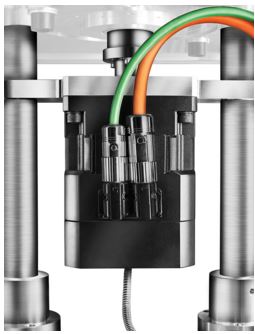 Direct Drive Motor
Direct Drive Motor
A powerful direct drive motor applies precise deformation in the MDR One. A high quality rheological or dynamic measurement relies on the precise application of a constant rate, step, or periodic deformation. In a direct drive system the start-up delays, compliance, and translational losses seen in clutch or belt driven configurations are eliminated. The superior motor design of the MDR One ensures that the most accurate and repeatable deformations are always applied to the sample.
The MDR One applies the highest combination of continuously variable frequency and amplitude in any rubber rheometer. This provides important material information such as:
- The linear viscoelastic response of highly filled rubbers at low strains
- Behavior at extreme processing and use conditions characterized by high strains
- Terminal material behavior exhibited at low frequencies
- Response to high speed deformations measured at high frequencies
Advanced Data Processing
Advanced Data Processing
The complex deformations and stress-strain response common to rubber testing demand the most advanced data processing techniques. The MDR One from TA Instruments utilizes a state-of-the-art 20 bit encoder and advanced data sampling technique to perform calculations based on a Fast Fourier Transform (FFT) analysis using 90 data points for each cycle of oscillation.
The MDR One measures and reports non-linearities in torque and displacement. Higher harmonics indicating non-linearity in the applied displacement or measured torque, are reported for each data point, alert the operator with a simple indicator if test conditions are not ideal and storing this information for subsequent data validation.
Cooling Options
Cooling Options
The MDR One is compatible with the Standard Air Cooling System. The Standard Cooling System uses ambient air to expedite temperature changes above ambient conditions and improve temperature stability near room temperature.
Dies & Rotors
Dies & Rotors
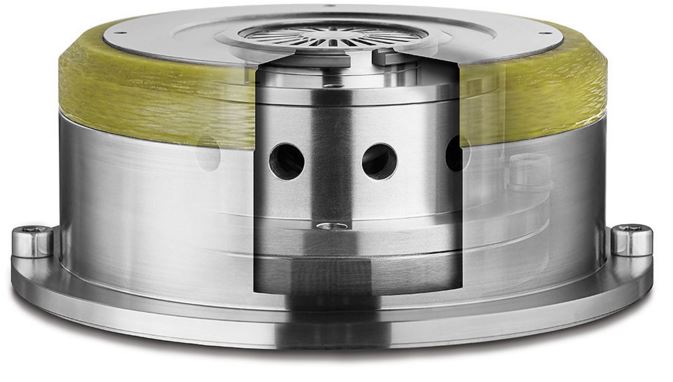
The MDR one, RPA flex, and RPA elite rotorless shear rheometers employ the industry-standard sealed cavity biconical die design. The dies are constructed from durable, high-stiffness, low thermal expansion stainless steel to minimize system compliance and prevent gap changes with temperature. The test fixtures are connected directly in line with the motor below for precision deformation control and the torque transducer above for accurate measurement.
Direct contact electric heaters mounted within the dies provide exceptional temperature control and stability under isothermal, step and temperature ramp conditions. This highly responsive system returns rapidly to the programmed test temperature upon the addition of a cold sample, providing the most representative values for scorch time and other cure characteristics. Extremely durable user-replaceable seals provide absolute sample containment at all temperatures and conditions.
Die Surfaces
Die Surfaces
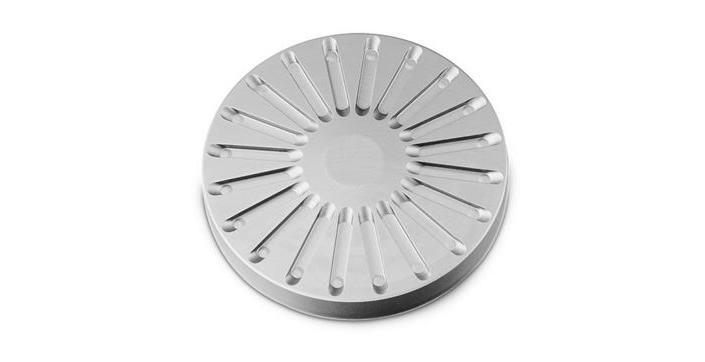
The MDR One die surfaces feature an optimized arrangement of radial serrations to guarantee constant sample contact at even the highest strain values. Polyester or polyamide films may be used to facilitate sample release and avoid the need to clean dies between experiments.
High Pressure Pneumatic System
High Pressure Pneumatic System
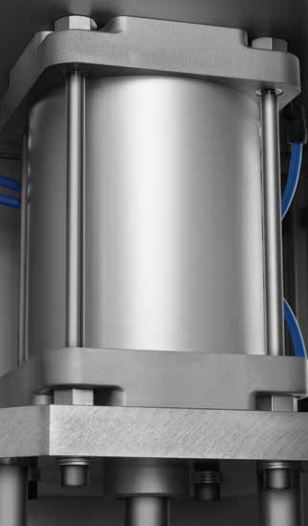 The MDR One employs a high pressure pneumatic system to seal the sample properly and reproducibly. The high capacity pneumatic system applies up to 4.5 bar nominal pressure to the during gap closure. Proper alignment and the use of mechanical bearings ensure efficient transfer of load from the system to the sample without load frame losses. Actual sealing pressure is measured directly and recorded. This high pressure automated sample containment removes operator dependence and tightly contains the test specimen. This sealing process is particularly important for materials that undergo positive or negative volumetric changes with curing and highly stiff materials such as carbon-filled fluoroelastomers.
The MDR One employs a high pressure pneumatic system to seal the sample properly and reproducibly. The high capacity pneumatic system applies up to 4.5 bar nominal pressure to the during gap closure. Proper alignment and the use of mechanical bearings ensure efficient transfer of load from the system to the sample without load frame losses. Actual sealing pressure is measured directly and recorded. This high pressure automated sample containment removes operator dependence and tightly contains the test specimen. This sealing process is particularly important for materials that undergo positive or negative volumetric changes with curing and highly stiff materials such as carbon-filled fluoroelastomers.
Torque Calibration
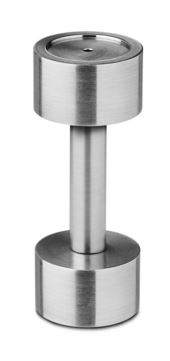 Torque Calibration
Torque Calibration
Torque calibration is made simple with a certified torque calibration device. This feature allows the user to calibrate the instrument directly, increasing data confidence and operation time, and reducing the reliance of service engineers for calibration.
Oscillation and transient tests of curing and viscoelasticity. These tests are the most common for rubber rheology and provide information about vulcanization and curing, viscoelastic properties, filler structure, polymer architecture, and more.
The RPA and MDR instruments perform oscillation, or dynamic measurements of polymer and rubber properties. These tests provide basic torque information, as well as viscoelastic properties such as the storage and loss modulus, tan δ, and viscosity. Oscillation tests are popular for studies of curing, or vulcanization, as well as measurements of viscoelastic properties, filler structure, polymer architecture, and more for both green and cured rubber.
Isothermal Cure
Isothermal Cure
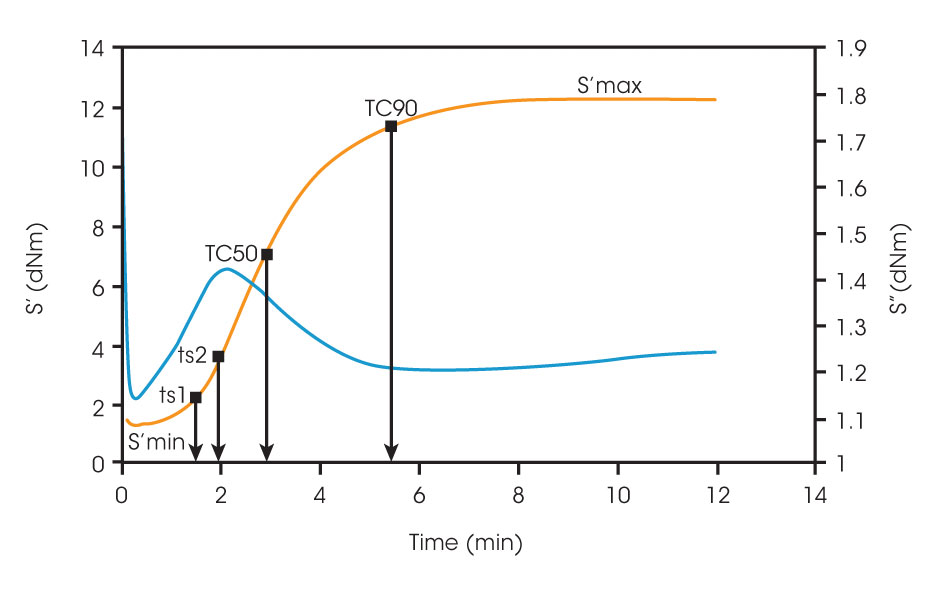
Isothermal cure experiments are critical for rubber and elastomer processing. The TA Instruments rubber rheometers provide high precision data that is simple to analyze. All the important characteristics, such as minimum and maximum viscosity, scorch time, and conversion time can be calculated easily and automatically. The data can also be handled in its complete graphical form for comparison or alternative analyses.
Suitable Instruments: MDR one, RPA flex, RPA elite
Non-isothermal Cure
Non-isothermal Cure
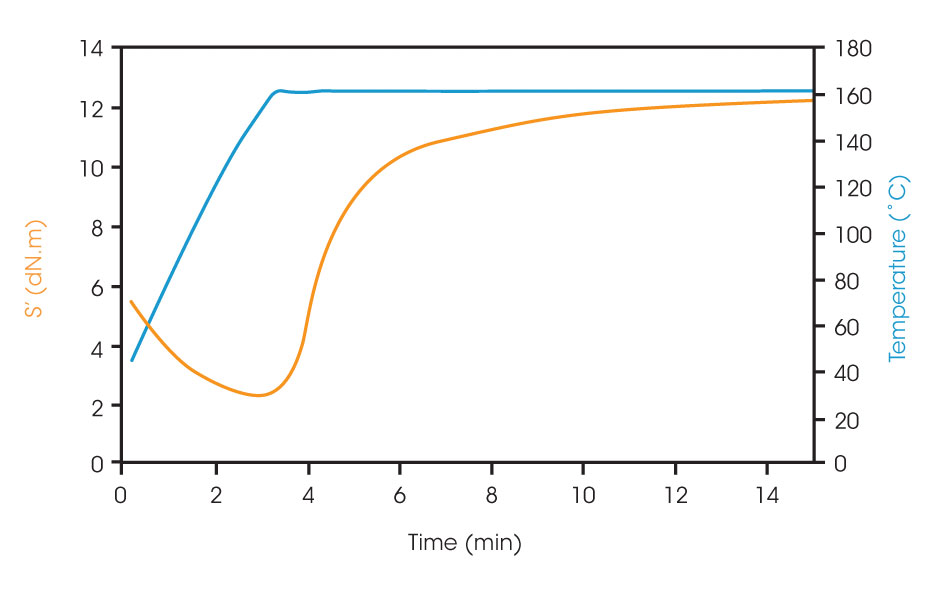
In addition to the industry-standard isothermal cure methods, the RPA and MDR can perform non-isothermal cure experiments. These experiments can be programmed to follow virtually any temperature profile and are especially valuable when simulating manufacturing processes that are not isothermal. Non-isothermal curing experiments may also be coupled with isothermal tests such as strain and frequency sweeps before or after cure to provide a more complete material data set before, through, and after cure.
Suitable Instruments: MDR one, RPA flex, RPA elite
Isothermal Curing at Variable Strain
Isothermal Curing at Variable Strain
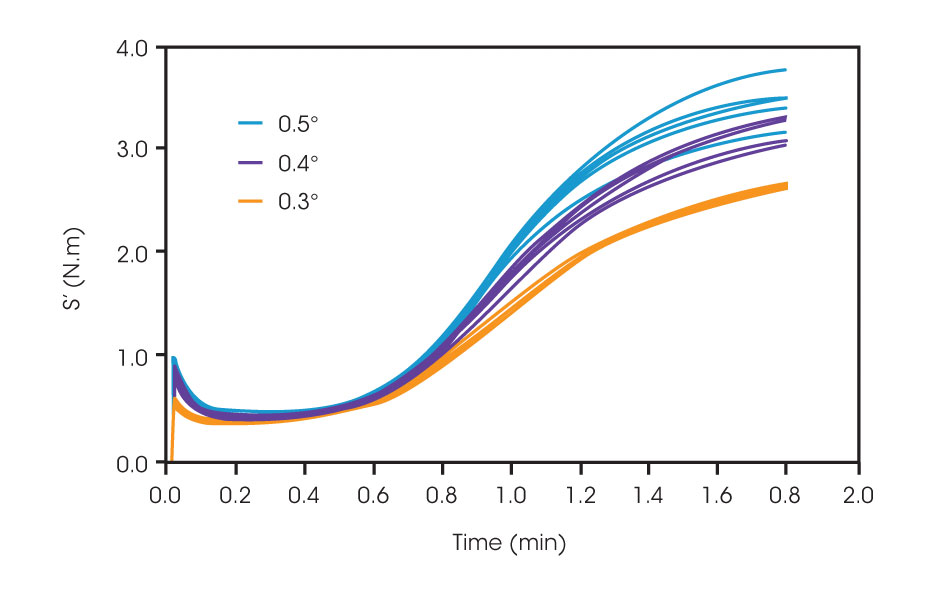
While standard test methods often call for a single strain and frequency value to be used for all materials (0.5°, 1.67 Hz), these are not always the ideal conditions for every material. In the present example, the sample material is tested by isothermal cure at three deformation amplitudes, five times each. At the standard of 0.5° and 0.4° the experimental variability is extremely broad. This is because these experiments are performed at strains beyond the linear viscoelastic limit for this material. Testing at a smaller amplitude (0.3°) produces valid data with greatly improved reproducibility.
Suitable Instruments: RPA flex, MDR one, RPA elite
Cure with Blowing Reaction
Cure with Blowing Reaction
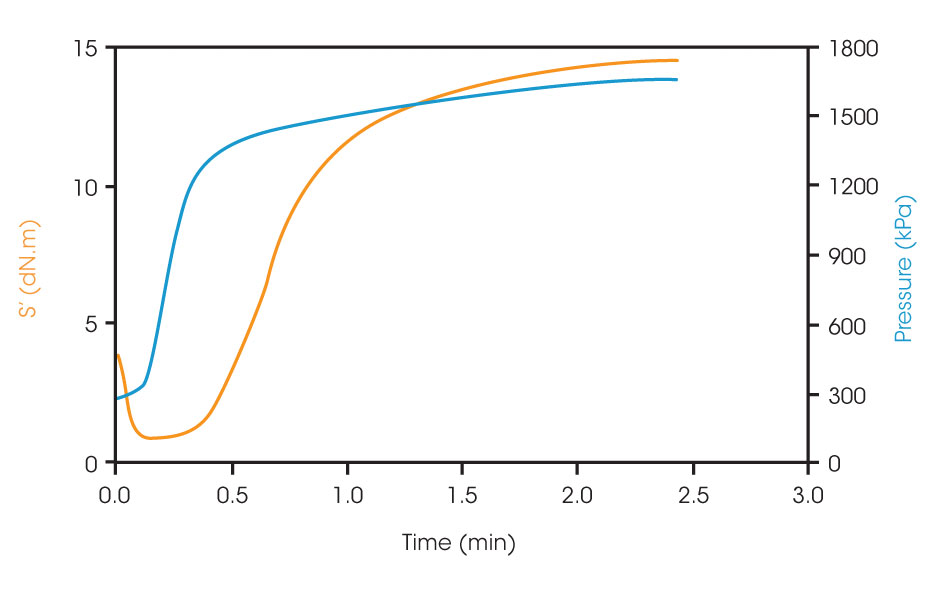
Final product density and mechanical performance are often enhanced through the use of blowing agents to create a cellular architecture. These blowing agents generate gas during decomposition in parallel with the curing reaction. Monitoring sample pressure through the curing reaction is an effective way to quantify the blowing reaction, allowing for the characterization of curing and blowing in a single experiment. These two processes must be balanced in order to form the desired cell architecture in the finished product.
Suitable Instruments: MDR one, RPA flex, RPA elite
- Description
-
The MDR one Moving Die Rheometer (MDR) is a reliable, accurate, and easy-to-operate rotorless curemeter perfect for routine and standards-driven testing of rubber curing. The MDR one is configured for measuring curing profiles of rubber compounds under isothermal and non-isothermal test conditions at constant strain and frequency.The MDR one employs sealed biconical dies meeting all relevant ASTM, ISO, and DIN standards.The unique design includes an ultra-rigid test frame, direct drive motor, precision temperature control with optional cooling and intuitive Scarabaeus Control and Analysis software making it the ideal platform for QC or R&D environments.
Features
- Unmatched data precision, accuracy, and reproducibility
- Robust, field proven torque transducer for high stability and reliable torque measurements
- Extremely rigid test frame for accurate compliance free data
- Pneumatic locking cylinders for repeatable sample sealing
- Powerful and intuitive Scarabaeus Software available in multiple languages & compatible with other manufacturers’ instruments
- User calibration and user replaceable seals
- Specifications
-
Frequency 0.1 to 2.0 Hz (6 to 120 cpm) Amplitude ±0.1°, 0.2°, 0.5°, 1.0°, 3.0°, 5.0° arc Strain ±1.4%, 2.8 %, 7 %, 14 %, 42 %, 70 % Torque Range 0.001 to 20 Nm Temperature Ambient to 230 °C Maximum Ramp Rate 80°C/min (1.33°C/s) Die Type Sealed bicone, 0.48 mm gap Sample Volume 4.5 cm3 Platen Sealing Pressure Fixed: 4.5 bar Sample Pressure Optional: 0 to 8,300 kPa Test Modes Curemeter/Vulcanization both isothermal and temperature ramp Measured Data Torque, Temperature, Frequency, Amplitude, Sample Pressure (optional) Calculated Data More than 450 process parameters including: ts1, TC10, TC50, TC90, S’min, S’max, scorch time, cure rate, and viscoelastic properties including: G’, G”, G*, S’, S”, S*, tan δ, η’, η”, η* Standards ASTM D5289, ISO 6502, 13145; DIN 53529 - Technology
-
TA Instruments is the world’s leading supplier of analytical instrumentation for the measurement of viscosity and viscoelastic properties. The new rubber testing instruments are uniquely designed to deliver the highest quality of torque, amplitude, frequency, temperature, and pressure measurement and control setting the NEW STANDARD for testing of rubber products at all stages of manufacturing.
Rigid Testing Platform
 Rigid Testing Platform
Rigid Testing PlatformThe MDR One is built with an ultra-stiff testing frame and crosshead which eliminate the effects of instrument compliance on test data. Instrument compliance, or instrument deformation, produces erroneously low values of measured properties such as modulus and torque, irregular strain and torque waveform signals, and other errors.
Large diameter steel rods and a thick crosshead brace in the H-shaped load frame of the MDR One provide unmatched rigidity to resist instrument deflection while the motor deforms the sample. This special design ensures that the commanded strain is achieved with each cycle of deformation, even for highly filled, fully cured rubbers. Additionally, a non-compliant system allows for truly sinusoidal strain profiles under all conditions. This can be verified by continuous Fourier Transform analysis of the deformation and measured torque signals which is available in the Scarabaeus Software. The superior design also guarantees smooth travel, proper alignment, and precise application of vertical load.
Direct Drive Motor
 Direct Drive Motor
Direct Drive MotorA powerful direct drive motor applies precise deformation in the MDR One. A high quality rheological or dynamic measurement relies on the precise application of a constant rate, step, or periodic deformation. In a direct drive system the start-up delays, compliance, and translational losses seen in clutch or belt driven configurations are eliminated. The superior motor design of the MDR One ensures that the most accurate and repeatable deformations are always applied to the sample.
The MDR One applies the highest combination of continuously variable frequency and amplitude in any rubber rheometer. This provides important material information such as:
- The linear viscoelastic response of highly filled rubbers at low strains
- Behavior at extreme processing and use conditions characterized by high strains
- Terminal material behavior exhibited at low frequencies
- Response to high speed deformations measured at high frequencies
Advanced Data Processing
Advanced Data Processing
The complex deformations and stress-strain response common to rubber testing demand the most advanced data processing techniques. The MDR One from TA Instruments utilizes a state-of-the-art 20 bit encoder and advanced data sampling technique to perform calculations based on a Fast Fourier Transform (FFT) analysis using 90 data points for each cycle of oscillation.
The MDR One measures and reports non-linearities in torque and displacement. Higher harmonics indicating non-linearity in the applied displacement or measured torque, are reported for each data point, alert the operator with a simple indicator if test conditions are not ideal and storing this information for subsequent data validation.
Cooling Options
Cooling Options
The MDR One is compatible with the Standard Air Cooling System. The Standard Cooling System uses ambient air to expedite temperature changes above ambient conditions and improve temperature stability near room temperature.
Dies & Rotors
Dies & Rotors

The MDR one, RPA flex, and RPA elite rotorless shear rheometers employ the industry-standard sealed cavity biconical die design. The dies are constructed from durable, high-stiffness, low thermal expansion stainless steel to minimize system compliance and prevent gap changes with temperature. The test fixtures are connected directly in line with the motor below for precision deformation control and the torque transducer above for accurate measurement.
Direct contact electric heaters mounted within the dies provide exceptional temperature control and stability under isothermal, step and temperature ramp conditions. This highly responsive system returns rapidly to the programmed test temperature upon the addition of a cold sample, providing the most representative values for scorch time and other cure characteristics. Extremely durable user-replaceable seals provide absolute sample containment at all temperatures and conditions.
Die Surfaces
Die Surfaces

The MDR One die surfaces feature an optimized arrangement of radial serrations to guarantee constant sample contact at even the highest strain values. Polyester or polyamide films may be used to facilitate sample release and avoid the need to clean dies between experiments.
High Pressure Pneumatic System
High Pressure Pneumatic System
 The MDR One employs a high pressure pneumatic system to seal the sample properly and reproducibly. The high capacity pneumatic system applies up to 4.5 bar nominal pressure to the during gap closure. Proper alignment and the use of mechanical bearings ensure efficient transfer of load from the system to the sample without load frame losses. Actual sealing pressure is measured directly and recorded. This high pressure automated sample containment removes operator dependence and tightly contains the test specimen. This sealing process is particularly important for materials that undergo positive or negative volumetric changes with curing and highly stiff materials such as carbon-filled fluoroelastomers.
The MDR One employs a high pressure pneumatic system to seal the sample properly and reproducibly. The high capacity pneumatic system applies up to 4.5 bar nominal pressure to the during gap closure. Proper alignment and the use of mechanical bearings ensure efficient transfer of load from the system to the sample without load frame losses. Actual sealing pressure is measured directly and recorded. This high pressure automated sample containment removes operator dependence and tightly contains the test specimen. This sealing process is particularly important for materials that undergo positive or negative volumetric changes with curing and highly stiff materials such as carbon-filled fluoroelastomers.Torque Calibration
 Torque Calibration
Torque CalibrationTorque calibration is made simple with a certified torque calibration device. This feature allows the user to calibrate the instrument directly, increasing data confidence and operation time, and reducing the reliance of service engineers for calibration.
- Capabilities
-
Oscillation and transient tests of curing and viscoelasticity. These tests are the most common for rubber rheology and provide information about vulcanization and curing, viscoelastic properties, filler structure, polymer architecture, and more.
The RPA and MDR instruments perform oscillation, or dynamic measurements of polymer and rubber properties. These tests provide basic torque information, as well as viscoelastic properties such as the storage and loss modulus, tan δ, and viscosity. Oscillation tests are popular for studies of curing, or vulcanization, as well as measurements of viscoelastic properties, filler structure, polymer architecture, and more for both green and cured rubber.
Isothermal Cure
Isothermal Cure

Isothermal cure experiments are critical for rubber and elastomer processing. The TA Instruments rubber rheometers provide high precision data that is simple to analyze. All the important characteristics, such as minimum and maximum viscosity, scorch time, and conversion time can be calculated easily and automatically. The data can also be handled in its complete graphical form for comparison or alternative analyses.
Suitable Instruments: MDR one, RPA flex, RPA elite
Non-isothermal Cure
Non-isothermal Cure

In addition to the industry-standard isothermal cure methods, the RPA and MDR can perform non-isothermal cure experiments. These experiments can be programmed to follow virtually any temperature profile and are especially valuable when simulating manufacturing processes that are not isothermal. Non-isothermal curing experiments may also be coupled with isothermal tests such as strain and frequency sweeps before or after cure to provide a more complete material data set before, through, and after cure.
Suitable Instruments: MDR one, RPA flex, RPA elite
Isothermal Curing at Variable Strain
Isothermal Curing at Variable Strain

While standard test methods often call for a single strain and frequency value to be used for all materials (0.5°, 1.67 Hz), these are not always the ideal conditions for every material. In the present example, the sample material is tested by isothermal cure at three deformation amplitudes, five times each. At the standard of 0.5° and 0.4° the experimental variability is extremely broad. This is because these experiments are performed at strains beyond the linear viscoelastic limit for this material. Testing at a smaller amplitude (0.3°) produces valid data with greatly improved reproducibility.
Suitable Instruments: RPA flex, MDR one, RPA elite
Cure with Blowing Reaction
Cure with Blowing Reaction

Final product density and mechanical performance are often enhanced through the use of blowing agents to create a cellular architecture. These blowing agents generate gas during decomposition in parallel with the curing reaction. Monitoring sample pressure through the curing reaction is an effective way to quantify the blowing reaction, allowing for the characterization of curing and blowing in a single experiment. These two processes must be balanced in order to form the desired cell architecture in the finished product.
Suitable Instruments: MDR one, RPA flex, RPA elite
- Resources







